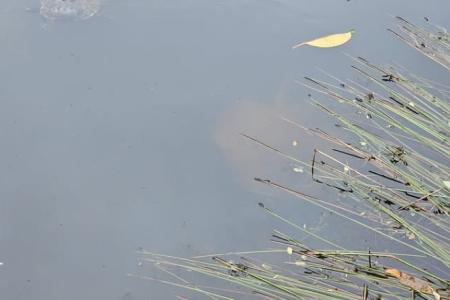Public advised not to fish, enter pond in Seletar park after ray sighting
A ray of an unknown species was spotted in a pond at Hampstead Wetlands Park in Seletar Aerospace Park, though it is unclear how it got there.
Mr Yeong Wai Kai, 61, caught sight of the ray on Jan 19 for about 10 seconds and managed to take a photo of the fish, which he then posted to Facebook group Singapore Wildlife Sightings.
“I noticed a diamond-shaped object below the surface moving in a straight line directly to where I was standing. It then went deep and under the reeds at the edge of the pond,” the retiree told The Straits Times.
Mr Yeong said he suspects the ray was put in the pond by someone, as it is a closed pond and not connected to other bodies of water.
In response to an ST query, the National Parks Board’s (NParks) parks central group director Tan Jun Chao said the agency has been alerted to the ray sighting and is monitoring the situation.
“Members of the public should not fish or enter the pond for their own safety,” he added.
Marine scientist Naomi Clark-Shen, who is the ocean-climate programme lead at Rumah Foundation, told ST that while it is hard to make out the species of the ray based on the photograph, it could be a released pet.
“The fact that so many of these end up in our reservoirs implies that they are difficult pets, or that people easily get bored of them.
“It’s also highly likely that they don’t enjoy living in a tank… so whether living in a tank or released into a pond, neither is ideal,” she said.
There are over 600 different ray species globally.
A study by the National University of Singapore published in 2021 found that up to 16 elasmobranch species – a group of marine creatures that include rays – have swum in Singapore’s waters in recent years.
Rays that have been spotted in our waters include the blue-spotted ray and the white-spotted eagle ray.
NParks’ Mr Tan said the ray’s presence in the pond could be the result of an unauthorised release.
He urged people not to release animals into Singapore’s parks and nature reserves, as the animals may not be able to fend for themselves.
In Singapore, it is illegal to keep protected ray species including devil rays and flying rays.
Those caught releasing wildlife can be fined up to $5,000.
In 2017, a man was fined $2,600 after releasing three venomous motoro stingray pets into Lower Seletar Reservoir. The rays can deliver venomous stings that cause extreme pain and even death.
Members of the public can report anyone releasing wildlife at avs.gov.sg/feedback or call 1800-476-1600.
“As with all investigations, all forms of evidence are crucial to the process, and photographic and/or videographic evidence provided by the public will help,” said Mr Tan.
Get The New Paper on your phone with the free TNP app. Download from the Apple App Store or Google Play Store now


